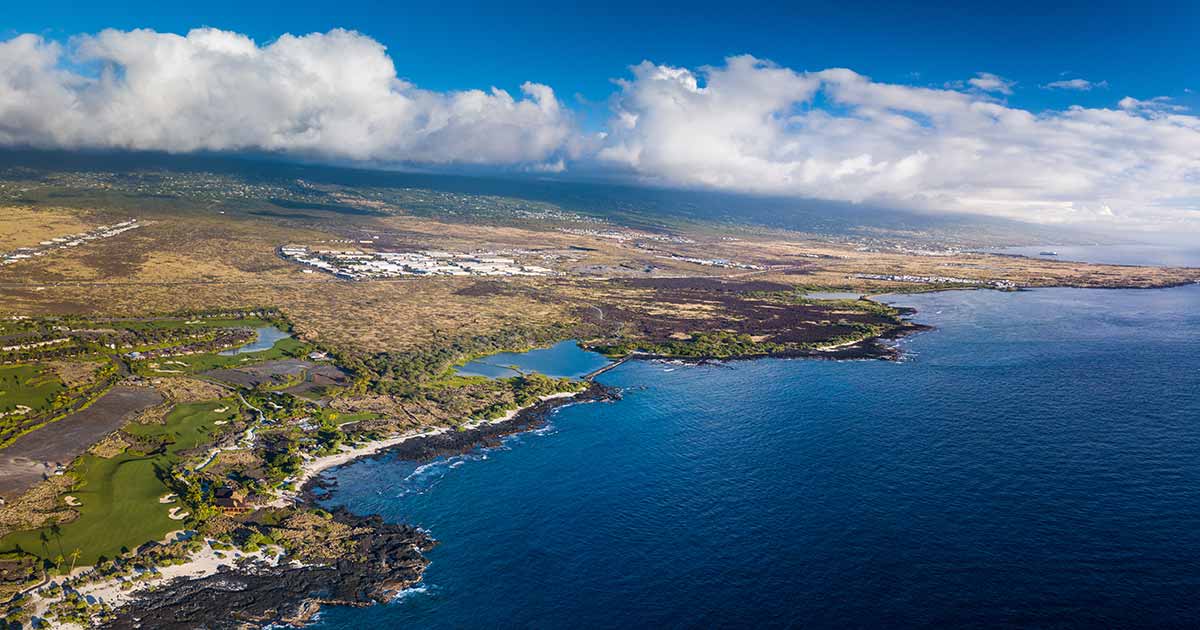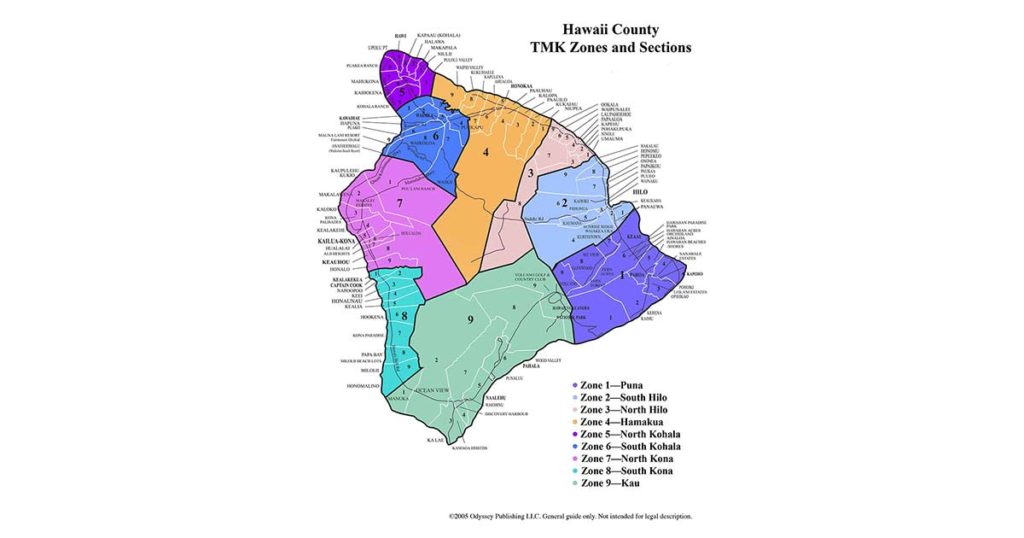WHEN CONSIDERING MOVING TO THE BIG ISLAND OF HAWAII… One must understand the differences between the nine districts, the eight to ten climate zones (depending on which resource you subscribe to), the nine lava zones, the four land designations, the cultural nuances, and how everything affects home, condo and land prices. There is a lot to learn, but doing your homework will insure a better chance of happiness in paradise!
Prior to Pat and I moving to the Big Island in 2011, Pat went to the NOAA website to study the weather patterns for the previous 20 years. He knew I needed sun on a regular basis and wanted to be sure we didn’t end up with more drizzle than I could handle.
Let’s say that you are like me/us, and you want livestock such as horses, goats, chickens, cattle and the like, plus some sun and potentially a great sunrise with potential ocean views.
What he didn’t realize at that time was that the proper grazing of my elderly horse was more important to me than the number of sunny days per year. In Hawaii, rain equals lush tropical vegetation, where consistent sun equals a great suntan but more lava and less deep soil with lush grass. We traveled to the Big Island four times in four years prior to making the big move. We called these trips “reconnaissance trips” because our goal was to determine which area we felt called to. We focused only on North and South Kohala and the Hamakua Coast based on weather, topography and home/land prices. Our poor Realtor® was such a sport in taking us to see at least three dozen properties. Some could be referred to as love shacks, some were vacant land, some were fixer uppers, and one place melted our hearts. We made an offer on that place – 12 acres, a pond, ocean view, tucked into the Ohiʻa forest on the Hamakua Coast. But, our home didn’t sell so we lost it. We were heart broken, to say the least.
But hindsight IS 20/20, and by the time we actually made the move to the tiny ranching community of Paauilo, to a rented vintage yurt, I might add, we were confident that living in Paauilo, on the Hamakua Coast, was where we were meant to be. Fourteen months after moving into the rented yurt, we moved out and into our permanent home just a half mile away as the wild turkey flies. We jokingly say that my horse, Smoke, was the one that determined our final residence. More on all that later.
Sun, trade winds, cool temps, ranching, ocean views, affordable versus not so affordable
So, if you are set on lots of sun, and you have a decent buy budget, you will want to look at lower South Kohala, South and North Kona, Waikoloa Village, and the dry side of Waimea. If you simply have to have an ocean view with sunsets, and you have a good buy budget, you will want to focus on North and South Kohala, Waikola Village, the dry side of Waimea, and into South and North Kona. Let’s say that you are like me/us, and you want livestock such as horses, goats, chickens, cattle and the like, plus some sun and potentially a great sunrise with potential ocean views. You will most likely want to look at the green side of Waimea all the way down the Hamakua Coast and into Hilo. Now, if you are on a budget, a serious budget, and this is the driving force, you will want to focus on the Puna and K’au areas. This is where you can buy a vacant lot for as low as $8,000.00, then build your home, maybe a package home, yurt or dome, and often get a nice ocean view. But, you may not be near a town, and you may have a lot of lava; you will pay dearly for home insurance (Lava Zones 1 and 2), you may, at some point in your lifetime, have a volcanic eruption scare. But, you will be living in paradise.
The Big Island offers something for every lifestyle and every budget. Just be patient as it sometimes requires…patience!
the nine districts of the big island
Here’s a tiny snapshot of what each of the nine districts has to offer.
Click the map for a larger version
District/Zone 1 – Puna
Sometimes referred to as “The Last Hawaiian Frontier” and located at the lower east corner of the island, Puna offers affordable properties within communities like Mountain View, Kurtistown, Hawaiian Acres and Fern Acres. Off-grid living options also help to keep utility costs more attractive. The town of Volcano, which splits the Puna and K’au Districts, sits in a lush rainforest within close proximity to Volcanoes National Park, a must see! In the upper areas you can expect cooler temps.
Average annual rainfall – 100”
Lava Zones: 1, 2 and 3.
Climate Zone: Tropical Continuously Wet, Continuously Wet-Warm Temperate
District /Zone 2 – South Hilo
South Hilo is at the lower eastern side of the island and sits to the north of Puna. This area offers a wide variety of living options from postage-stamp lots with camp homes dating back to the sugarcane era, to high-end homes with expansive agriculture and livestock acreage in the upper, cooler areas. Hilo is the Hawaii County Seat and home of the island’s major state and federal offices, Hilo International Airport, medical center, the University of Hawaii-Hilo, and Imiloa Astronomy Center. Hilo Town boasts beautiful views of the ocean from its crescent shaped bay, and Queen Lili’uokalani Park within walking distance. Downtown offers many museums, shopping, and restaurants. Travel about four miles out of town and surf at Honolii, the most popular surf spot on the east side of the island. Yes, Hilo can typically get “liquid sunshine” almost every day of the year, yet most days enjoy plenty of sunshine.
Average annual rainfall – 136”
Lava Zones: 2 & 3
Climate Zone: Continuously Wet-Warm Temperate
District/Zone 3 – North Hilo
Traveling north up Highway 19, you notice many small towns accessed directly off the highway – Umauma, Ninole (with the country’s smallest post office), Papaalaoa, Lapahoehoe and Ookala. Wonderful places that provide privacy, lush tropical landscape, cooler temperatures and regular rainfall, with both small and larger acreage for the farmer or rancher. Yes, waterfalls in abundance and beautiful ocean views atop rocky cliffs! Home and land prices are still affordable depending on size and location. Be sure to visit the Honomu Goat Dairy, the Railroad Museum, and Akaka Falls.
Average annual rainfall – 136”
Lava Zones: 3
Climate Zone: Continuously Wet-Warm Temperate
District/Zone 4 – Hamakua
The Hamakua Coast sits on the east side of the island, and offers rich agricultural acreage that is perfect for the large or small farmer and rancher. Off-grid living, although not the only lifestyle option, has been a way of life for many residents long before it became popular. With a commitment to sustainability, this community seeks to balance growth and progress with respect for the ‘aina, the land. Starting at spectacular Waipio Valley, with it’s three magnificent waterfalls and black sand beach, this area of the island has almost two dozen towns along Highway 19/Mamalahoa Highway toward North Hilo. The Hamakua Coast became popular during the sugarcane era, with many postage stamp vintage homes located in original camp towns still in existence. Historical Honokaa Town is the major hub for residents and visitors, and located to the north end of the coast. It offers grocery stores, The People’s Theater, hospital, local shopping and restaurants, library, skate park, annual rodeos and parades, music festivals, and the Hamakua Harvest Farmer’s Market. Real estate in this district is more affordable than properties along the North and South Kohala coasts. Cooler temps, amazing ocean views, and wonderful sunsets promise a calm and peaceful way of life.
Average annual rainfall – 80-160″
Lava Zones: 8
Climate Zone: Tropical Monsoon, Continuously Wet-Warm Warm Temperate
District/Zone 5 – North Kohala
As you leave the quaint town of Waimea, also called Kamuela, and the harbor town of Kawaihae, you head to the northern most tip of the Big Island. The drive is spectacular, whether you take the lower road that parallels the ocean, or the more scenic upper tree-lined road that winds through expansive pasture lands. This is where you find Hawi and Kapaau, two communities that share amenities to include a hospital, grocery store, radio station, the North Kohala Community Resource Center, shopping and restaurants, plus spectacular ocean and sunset views. Also considered an agriculture area, those in search of a slower, yet up-scale pace of life can find it here. You will enjoy cooler temperatures, sun and rain, as well as a bit more humidity and trade winds than other areas on the island. Land and home prices command a premium, but smaller acreage and the occasional fixer upper is always a good value. As you head back south you come to Kohala Ranch and Kohala Estates, large parcels of land with and without well-appointed homes that offer sweeping coastal views, and breathtaking sunsets. Although these areas are noted as equestrian, they really aren’t. But they do offer as much sun as you would want, with warm temps and those fabulous trade winds.
Average annual rainfall – 60 to 80”
Lava Zones: 9
Climate Zone: Continuously Wet-Warm Temperate, Summer-Dry Warm Temperate
District/Zone 6 – South Kohala
The South Kohala District offers the most variety of all nine districts. At the upper north and slightly inland, you find Waimea, also called Kamuela, one of the most popular Big Island towns steeped in Hawaiian history. There are three distinct sections: The “green” side, just west of Honokaa, offers both large and small acreage ideal for agriculture and livestock. The many sub-divisions closer to town also provide more affordable homes and on-grid living. The regular mist and rain keeps this area in cool temperatures. Mid-Waimea offers small community necessities with a sophisticated western flair and include a hospital, grocery stores, restaurants, shopping, a variety of farmer’s markets, the Paniolo Preservation Society, famed Parker Ranch, highly-regarded schools, cultural events, and the Kahilu Theater. Then there is the “dry” side as you head toward the coast. Homes are more expensive, typically more lavish, often with amazing views of Mauna Kea and the coast. Travel inland and you discover Waikoloa Village, a wonderful community originally created for the coastal hotel workers. This area is more affordable, offering homes, condos and land. Brace yourself…it gets down right hot in Waikoloa Village! But you can enjoy great ocean views, shopping, a grocery store, beautiful golf course, schools, many churches, and sunsets to die for. Last but certainly not least is the resort district found along the coast. Whether a full or part-time resident, those choosing to live on the northern west side of this district enjoy all the luxuries money can buy. Surf, sand, sports, sophisticated shopping, restaurants, and a high-end movie theater are just some of the amenities available year-round. Luxury homes and condos are available up and down this part of the coast and include the internationally famous Mauna Kea and Hapuna Prince Resorts, the Mauna Lani, Hualalai, and the Four Seasons.
Average annual rainfall – 8 to 30”
Lava Zones: 3 & 8
Climate Zone: Hot Semi-Desert, Summer-Dry Warm Temperate, Summer-Dry Cool Temperate
District/Zone 7 – North Kona
The International Kailua-Kona Airport sits on the coast of North Kona and is a hub for visitors worldwide, and locals both coming and going. I remember the first time I landed at this airport. I was in my early 20’s, thinking we couldn’t possibly be on a tropical island as my eyes spanned the charcoal black lava surrounding me. Upper North Kona offers agriculture and is the only place in the United States with the marriage of both coffee and cacao (chocolate.) This district is the industrial hub of the island, with a wide variety of large and small businesses, car dealerships, outside shopping centers to include Target, Walmart, Macy’s and Costco, as well as dozens of wonderful shops and restaurants. Real estate in this area comes at a premium price. Sub-divisions dot the lower hillsides, while high-end properties boarder the coast and mauka (up mountain), with condos, vacation rentals, boutique and larger hotels also found along the coast and lower hillsides. Demand almost always exceeds the supply. This district is also very popular as a surf spot with Pine Trees offering great waves, a long stretch of white sand beach, and affordable family camping. Honokohau Harbor provides world class sport fishing, boat launching and on/off water storage. Typically between the months of May and October, many of the world’s finest cruise lines anchor on the outskirts of Kailua Bay, sending their tenders to shore filled with vacationers anxious to shop and dine along beautiful tree-lined Alii Dr. What about the weather? I have dear friends who live in lower Kona and I often refer to their climate as, “Turning the oven on to 425 degrees, waiting 20 minutes, then sticking your head in.” It is hot and dry in Kona! But, she and her hubby love it, and we do too…when we want to get out of the cool temps of Paauilo, head to the beach, or brave the crowds at Costco. We also have wonderful friends who own a coffee farm mauka. They enjoy cooler temperatures, drizzle or rain usually later in the day, and to-die-for ocean views.
Average annual rainfall – 8 to 40”
Lava Zones: 3 & 4
Climate Zone: Tropical Wet and Dry
District/Zone 8 – South Kona
As you head south along the coast, you find more homes and less industry. This is South Kona. The weather tends to be the same, yet the vibe changes from visitors to locals – Kama’aina. Small towns include Kealakekua, Captain Cook and all the way down to Honomalino; towns rich in Hawaiian history and built on the hard work of ranchers and farmers. Each neighborhood is its own micro-culture from tidy sub-divisions to custom homes, cottages, bed & breakfasts, condos, commercial properties, farms and ranches.
Average annual rainfall – 8 to 50”
Lava Zones: 8
Climate Zone: Tropical Winter-Dry, Continuously Wet-Warm Temperate
District/Zone 9 – Kaʻu
The Kaʻu District is at the southernmost end of the Big Island. It is also the southernmost point of the United States. Here, you will find the largest district yet the least inhabited. Kaʻu offers desert-like conditions with an open landscape of lava and low-growing brush situated between magnificent mountain ranges and the glistening ocean. Miles of pitch black lava reminds you that Kilauea, located in Volcanoes National Park, is still part of the most current history of our island. In addition to visiting the park and it’s Visitor Center, you can also enjoy lunch and a round of golf at Volcano Golf and Country Club. Small coastal villages include Pahala and Naalehu, plus sub-divisions in Hawaiian Ocean View Estates (HOVE), Hawaiian Ocean View Ranchos, and Discovery Harbour, with real estate that is affordable, often off-grid and includes homes, ranches, and farms. Vacant land can be found as low as $8,000! Visitors and locals love to frequent Punalu’u Bakery and Visitor’s Center, the Windmill Farm, and Wood Valley with it’s ancient trees. If budget is an issue, and you seek peace and solitude, Kaʻu may be calling your name!
Average annual rainfall – 8 to 160”
Lava Zones: 1, 2, 3, 5 and 6
Climate Zone: Tropical Summer-Dry



